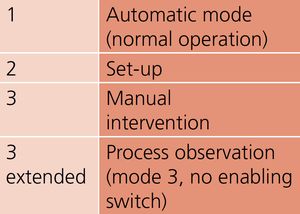KANBrief 2/17

In toolmaking and machine construction, custom part manufacture and development, conditions repeatedly arise in which the operator must intervene manually in the machining process whilst guards are open. An additional operating mode that permits observation of the process under safe conditions can prevent dangerous defeating of guards. However, the use of such an operating mode is permissible only when no other technical solutions are possible.
In exceptional cases, the EU Machinery Directive permits the operator of a machine or installation to observe the machining process with the guards open. One such case is during setup (operating mode 2) or manual operation (operating mode 3). These operating modes are permissible only for a limited duration and at reduced machine speeds. The use of substitute safety devices such as enabling switches is also required.
In practice however, these options are frequently not sufficient, or actuation of the enabling switch over a longer period of time cannot reasonably be expected. It is observed repeatedly in such cases that no effort is made to find safe solutions and that protective devices are instead simply defeated – in some cases permanently, because the special case repeatedly occurs.
The problem can be solved by provision of an additional "process observation" operating mode (also referred to as extended operating mode 3 or operating mode 4, for example when:
If such special conditions were not known to the operator of the machine at the time of its procurement, the manufacturer was not able to provide a suitable operating mode. Instead, the operator must consider organizational measures for performing the task without exposing his employees to greater risk. Experience has shown that it is difficult in these cases to find solutions that are compatible with the company's duty of care and with the statutory requirements.
Ideally, the company should work with the manufacturer, the authorities and the statutory accident insurance institution on producing a safe technical concept before purchasing a new machine. The resulting concept would hold the promise of greater acceptance, since all particular manufacturing conditions would be taken into account and the corresponding operating modes provided from the outset.
Last Resort
In many cases, the operator has been seen to be over-hasty in requiring a process observation operating mode. Technical alternatives have repeatedly been found that have permitted manufacture under the standard statutory and normative conditions.
Where this is not possible, particular consideration should be given to replacing technical protective measures by organizational measures for the purpose of process observation. Examples of such measures are the selection and training of workers, provision of particular and more frequent instruction, and strict management of the operating mode selector switch key. Management personnel have an important role, since the safety of workers is assured only when the organizational measures are observed carefully and action taken systematically against violations. Close awareness of this weak point is important.
The process observation operating mode is therefore the last resort and should be used only when a risk assessment has revealed beyond all doubt that no alternative exists for it.
Helmut Bach
helmut.bach@zf.com
Operating modes in standards
Criteria for provision of the "process observation" operating mode on machines were described as early as 2009 in a DGUV Informative Publication (Fachausschuss-Informationsblatt Nr. 2 (pdf, in german)). This proposal has been incorporated into standards, for example in Annex D of EN ISO 11161, Integrated manufacturing systems. An extended operating mode 3 (process observation) has also been introduced in the current Type C standards for machining centres (EN 12417) and milling machines (EN 13128). This operating mode is also found in the final draft of ISO 16090-1, which is intended to replace these standards.
In a comment to the European Machinery Committee, the British Health and Safety Executive (HSE) has adopted the standpoint that the entire operating mode 3 fails to satisfy the EU Machinery Directive. One argument for this standpoint is that operating mode 3 does not exploit the available technical solutions to the full. However, this operating mode is a normative compromise between highly individual, operator-oriented solutions, and requirements that are more general but lend themselves to standardization. Since no accidents during use of operating mode 3 on machining centres or other machine tools have been reported, we regard this as indicative that further development of EN 12417 in ISO FDIS 16090-1 is the correct approach for reducing the incentive to defeat or tamper with protective equipment.
Christoph Meyer, Chairperson of ISO TC 39 SC 10 WG 4, "Machining centres – Safety“,
christoph.meyer@bghm.de